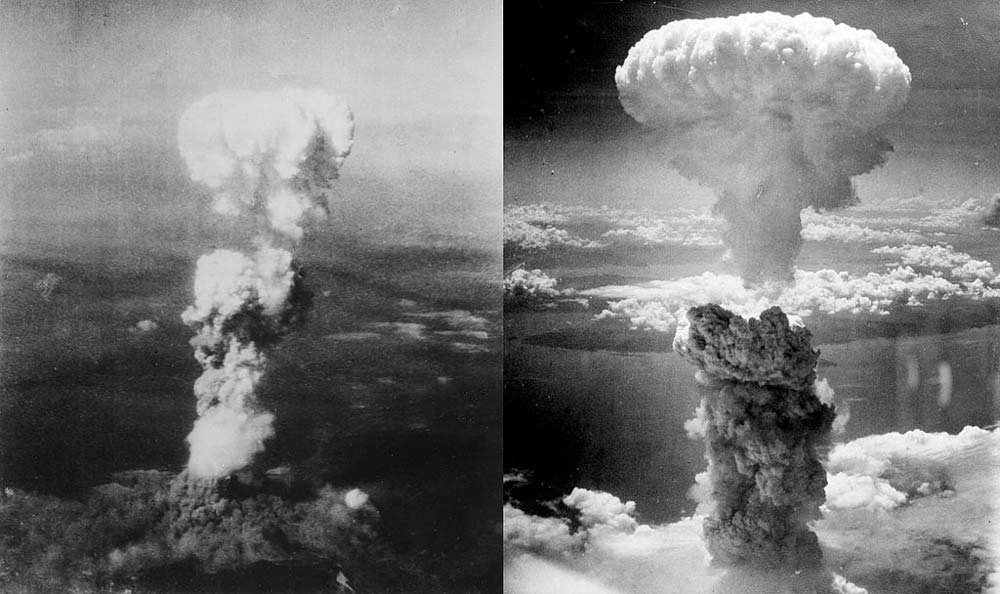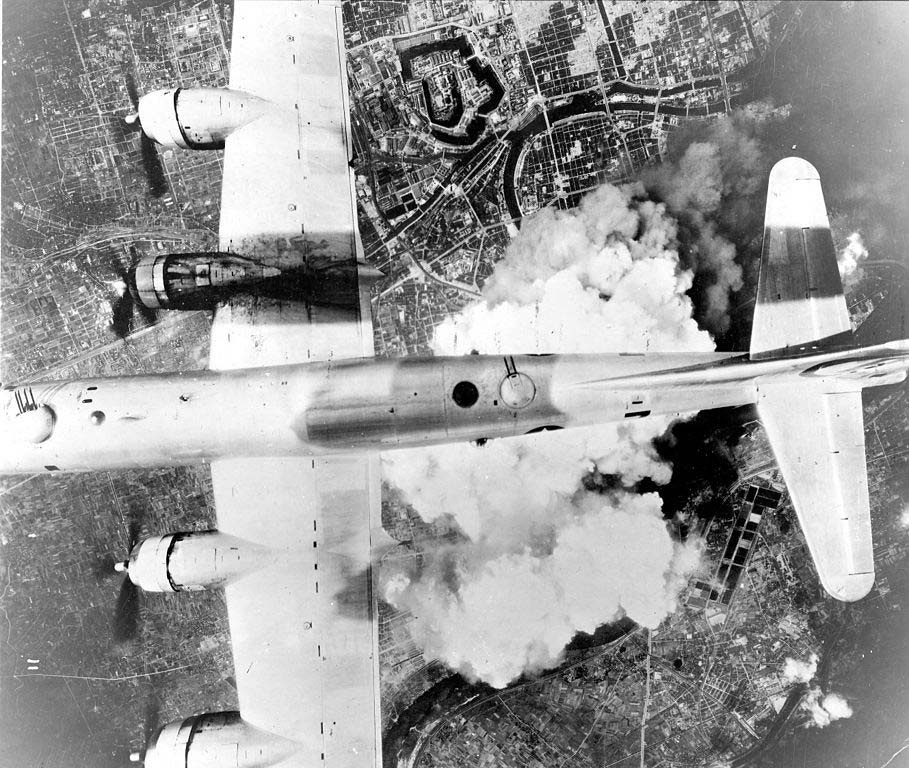| Atomic Bombings of Hiroshima and Nagasaki | |||||||
|---|---|---|---|---|---|---|---|
 |
|||||||
|
|||||||
| Contenders | |||||||
| Military Leaders | |||||||
| Military Units in Battle | |||||||
| Manhattan District 509th Composite Group |
Second General Army | ||||||
| Casualties and Deaths | |||||||
| None | Total: 150,000–246,000+ killed | ||||||
| 90,000–166,000 killed in Hiroshima 60,000–80,000 killed in Nagasak |
|||||||
| Part of World War II | |||||||
Japan had attacked Pearl Harbor in 1941, prompting the U.S. forces and her allies to enter war with Japan. The sea and air forces of the Allies attacked Japan until when she remained as the controller of just her homeland.
The U.S. attacked Japan on August 6, 1945 using a gigantic, atomic bomb, codename “Little Boy”, that was equivalent to 20,000 tons of TNT. The bomb was dropped in Hiroshima and destroyed the city, killing thousands of civilians. Three days later, the U.S. struck Nagasaki with yet another big bomb, codename “Fat Man”, that weighed over 10,000 pounds. These atomic bombings of Hiroshima and Nagasaki caused huge property loses as well as heavy casualties.
The Manhattan Project
The Manhattan Project was the name given to a top-secret program that was being spearheaded by the U.S. Army Corps of Engineers. In 1939, a group of Scientist from America started to get concerned about a research on nuclear weapon that Germany was conducting.
The United States government started to fund its atomic weapons development in 1940, under joint responsibility of the War Department and Office of Scientific Research after the United States’ entry in World War 2. Over the next few years, the project’s engineers concentrated on the main materials for nuclear fission: plutonium (Pu-239) and Uranium-235.
They then sent the materials to Los Alamos in New Mexico where Robert Oppenheimer led a team to turn the materials into a feasible atomic bomb. The Manhattan Project held its primary successful experiment of an atomic device on July 16, 1945 at Alamogordo, New Mexico.
Japan Refuses to Surrender
 The allied powers had defeated Germany in Europe, by the time the Alamogordo experiment was being conducted. However, Japan vowed to continue fighting in the Pacific despite clear indications that they had minimal chances of winning. To prove their point, between April and July 1945, Japanese forces had imposed Allied casualties that totaled to almost half of those suffered in 3 years of war in the Pacific. In late July that year, Japan’s militarist government turned down a demand from the Allied forces to surrender.
The allied powers had defeated Germany in Europe, by the time the Alamogordo experiment was being conducted. However, Japan vowed to continue fighting in the Pacific despite clear indications that they had minimal chances of winning. To prove their point, between April and July 1945, Japanese forces had imposed Allied casualties that totaled to almost half of those suffered in 3 years of war in the Pacific. In late July that year, Japan’s militarist government turned down a demand from the Allied forces to surrender.
General Douglas MacArthur and several military commanders favored the continuation of the straight bombing of Japan and following it up with an immense invasion. They advised President Truman that an invasion like that could result to about 1 million U.S. casualties.
Truman decided to use the atomic bomb, so as to avoid such high number of casualties. He hoped that that would bring the war to a rapid end. Supporters of the atomic bomb including the secretary of states, James Brynes, believed that the bomb would put U.S. in a governing position to establish the course of the post-war universe.
Hiroshima
 Hiroshima city is situated at the broad, flat Ota River delta. The city is slightly above the sea level and is generally flat. This city was considered to be of military importance, since it had the Second Army headquarters that commanded the defense of entire southern Japan.
Hiroshima city is situated at the broad, flat Ota River delta. The city is slightly above the sea level and is generally flat. This city was considered to be of military importance, since it had the Second Army headquarters that commanded the defense of entire southern Japan.
Moreover, this city acted as an assembly point for troops, communication center and a storage point. Earlier in the war, the population of this city had reached a climax of 380,000 but before the atomic bomb, this figure had reduced due to a regular evacuation order by the government of Japan. At the time of the bombing, the population was about 255,000.
The city of Hiroshima was the main target of the initial atomic bomb mission. The mission went on as planned and the outcomes were in accordance with expectations. The atomic bomb exploded over Hiroshima on the morning of August 6, 1945. At around 7:45 a.m., the Japanese early-warning radar net discovered an approach of some American aircraft that was heading toward the Southern part of Japan. The concerned people were alerted and radio broadcasting was stopped in most cities including Hiroshima. When the bomb exploded, great rush of air and a deafening rumble of noise extended for many kilometers around the city. This blast was followed by sounds of falling buildings and a huge cloud of dust and smoke.
Nagasaki
Nagasaki is located at the head of a long bay that forms the best natural harbor on the island of Kyushu. This city was one of the largest sea ports in the southern part of Japan. It was also important due to its numerous and varied industries. The long strip that was attacked was particularly important due to its industries. This city had not experienced any large scale bombing before the atomic bombing.
However, on August 1, 1945, several high explosive bombs were dropped, hitting the shipyards and Mitsubishi Steel and Arm Works. The bombs did not cause major damages but the authorities became concerned and evacuated some people especially school children.
At around 7:50 a.m. on August 9, 1945, there was an air raid alert in Nagasaki but it was later given an all-clear signal at 8:30 a.m. At 10:53 a.m., two B-29s were spotted, but the Japanese thought that the planes were on reconnaissance and therefore no alarm signal was issued. Moments later, the B-29 dropped some items attached to 3 parachutes. At 11:02 a.m., the other B-29 dropped the atomic bomb. This bomb exploded over the industrial valley of Nagasaki between Mitsubishi-Urakami Ordnance Works in the north and the Mitsubishi Steel and Arms Work (south).
Damages and Casualties
The atomic bombs caused huge losses and damages on people and properties in both cities. In Hiroshima, 60,000 buildings were severely damaged or destroyed by the heavy fire arising from the bomb. This represented over 67% of Hiroshima’s total structures. Before the explosion, Hiroshima had a population of 255,000. The bomb left 66,000 dead and 69,000 injured.
In the city of Nagasaki, 14,000 buildings were completely destroyed while 5,400 were half destroyed. Only 12% of the residences remained undamaged. The population of this city prior to the bombing was 195,000. The explosion inflicted a casualty number of 64,000, with 39,000 dead and 25,000 injured.
The Surrender
On August 15, 1945, at around noon, Emperor Hirohito made a radio broadcast announcement that his country had surrendered. The news spread rapidly and a V-J Day (Victory in Japan) revels broke out across the U.S. and the Allied nations. On September 2, 1945, the official surrender accord was signed aboard the U.S. aircraft carrier called Missouri, which was anchored in Tokyo Bay.